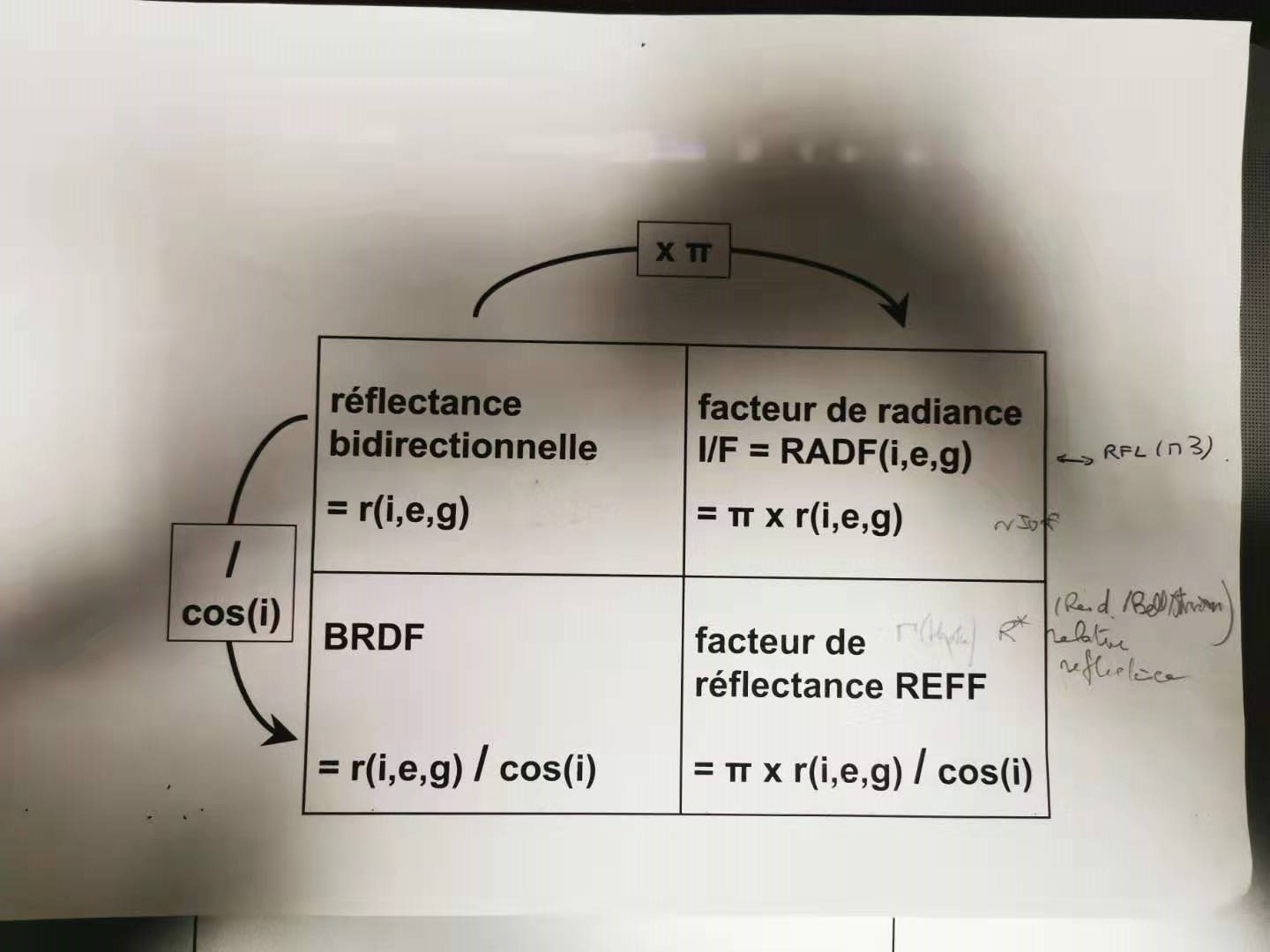- Introduction
In most applications of reflectance spectroscopy we are interested in the quantitative amount of light scattered by an infinitely thick layer of large particles.
one way of calculating this is to consider the microscopic processes that occur when a typical particle interacts with the radiation field inside the medium.
Collimated light incident on the medium is partly absorbed and partly scattered by direct encounter with particles in the upper layers.
The light that passes between these particles and the light scattered by them illuminates the given particle where it is partly absorbed and scattered into all directions.
The particle is heated by the light it absorbs and emits thermal radiation.
Some of the radiation scattered or emitted by the particle into an upward-going direction, passes between particles and escapes from the medium.
It is the combined light from all the particles that escapes from the upper surface of the medium that we wish to calculate.
当介质与辐射场共存时,一般有如下几个物理过程:
- 自发辐射( spontaneous emission):介质自发地发射光子
- 吸收( absorption):部分或全部辐射被介质吸收
- 受激辐射( stimulated emission):辐射经过介质时激发介质产生同频率同方向的辐射。
- 散射( scattering):入射光子与介质碰撞后改变方向甚至频率
- Basic Concepts
Let $\bf{J}= \bf{u}_p J$, where $\bf{u}_p$ is a unit vector pointing in the direction of propagation of $\bf{J}$.
- extinction cross section
power(功率,单位:W = J/s),irradiance(辐照度,单位:W/m2),所以界面的单位是面积单位,代表概率。
$P_E$ is the total amount of power of $\bf{J}$ that is affected by the particle.
- scattering cross section
- absorption cross section
An amount $P_S$ of $P_E$ is scattered into all directions, and the reminder $P_A$ is absorbed by the particle.
- geometrical cross-sectional area
- extinction,scattering and absorption efficiencies
- 截面的单位为面积
- 系数的单位为1,如大于1,表明比粒子横截面更大范围内的入射光被吸收(散射)
- size parameter: the ratio of the circumference of the particle to the wavelength.
The ratio of the total amount of power scattered to the total power removed from the wave is the particle single-scattering albedo,$\varpi$.
注:很多文献中,用’A’ 表示。
spat(译作“斯帕特”) function, or the effective single-particle absorption thickness
the efficiencies and the single-scattering albedo are functions of wavelength.
Assume that the particles are randomly oriented and positioned.
Let N be the number of particles per unit volume, $\sigma$ be the particle geometric cross-sectional area averaged over all orientations, $Q_E$ be their extinction efficiencies.
- Beer’s Law
- extinction coefficient
$E = N\sigma Q_E$
a mixture of different types of particles with $N_j$ particles of type j per unit volume, geometric cross sections averaged over all orieintations $σ_j$, volumes $υ_j$, and extinction, scattering and absorption efficiencies $Q_{Ej}, Q_{Aj}, and Q_{Sj}$, respectively.
- Number density(total numper of particles per unit volume)
$N = \sum_j N_j$
average distance $L = N^{-1/3}$
- filling factor: the fraction of space within the medium occupied by particles.
$\phi = \sum_j N_j v_j = N v$
$v = \phi/N$ is the avarage volume of a particle.
$1-\phi$ is the porosity.
填充因子是体积比.
- volume-average particle cross-sectional area
$\sigma = \left(\sum_j N_j \sigma_j \right) /N$
以上的定义其实是为了理解,真实情况下很难得到一个不规则粒子各个方向的最大截面积的平均值的。
- average particle size : the diameter of an equivalent sphere with the average cross-sectional area $\sigma$
$D = \sqrt{4\sigma/\pi}$
- volume-average extinction efficiency
$E = \sum_j N_j\sigma_j Q_{Ej} = N\sigma Q_E$
$Q_E = E/{n\sigma}$
volume-average absorption and scattering efficiencies in a similar way.
- volume angular scattering coefficient
- volume-average single-particle phase function
$p(g) = G(g)/S$
normalization condition:
- volume-average single scattering albedo
$w = S/E$
- abeldo factor
$\gamma = \sqrt{1-w}$
- volume-average asymmetry factor: the average value of the cosine of the scattering angle θ weighted by the particle phase function
- extinction mean free path $\Lambda_E$ is the average distance a photon travels through the medium before being extinguished by either absorption or scattering
the absorption and scattering mean free paths are in the similar way.
- transport coefficient
$S_T = S (1-\xi)$
correspondingly, transport mean free path:$\Lambda_T = 1/(S(1-\xi))$
each of these quantities may depend on both location and direction of the incident radiance.
- optical depth
由于介质的散射和吸收,一束光穿过介质后其强度为$I = I_0 e^{-\int_0^L E(s)ds}= I_)e^{-\tau}$,入射光强随光深成指数减小,$I/I_0 = e^{-\tau}$.从光的粒子属性出发,则$I/I_0 = nh\nu /n_0 h\nu = n/n_0 = e^{-\tau}$。由此可知,光子穿过光深为$\tau$ 的介质逃逸(不被吸收和散射)的概率为$n/n_0= e^{-\tau}$,那么被吸收和散射的概率为$1-e^{-\tau}$. 当介质的光深很小时,光子被吸收或散射的概率为$1-e^{-\tau}\sim \tau$,而当介质的光深为无穷大时,进入介质的光子基本上都被吸收。
$\tau > 1 $的介质称为光学厚的(optical thick),$\tau < 1 $的介质称为光薄的(optical thin)
- transmissivity function
$I(s_2) = I(s_1) T(s_1,s_2)$
- 在密堆积粒子中,该式需要作出修正
- volume emission coefficient $F(s,\Omega)$ as the power emitted per unit volume by the element at position s into unit solid angle about direction $\Omega$.
$F(s,\Omega) = F_s(s,\Omega) + F_T(s,\Omega)$
- single scattering
thermal emission
the general form of the equation of radiative transfer.
- 消光项,入射光被散射和吸收后,在入射方向上减少
- 散射项,从其他方向散射到入射方向的光
- 发射项,
- 单次散射项
- 热发射项,由吸收引起
- 荧光发射项,一般不考虑
- 受激辐射项,一般也不考虑,或在吸收系数里加一个负项表示
定义源函数:
the parameters of the equqtion of radiative transfer are determined by the properties of the particles making up the medium.
- the equqtion of radiative transfer(7.38式)
水平分层介质;
volume single-scattering albedo: $w(z) = S(z)/E(z)$
- Radiative transfer in a medium of arbitrary particle separation
- Fresnel diffraction in particulate media
- Coherent effects in a close-packed medium
- The transmissivity of a particulate medium
- Radiative transfer in a particulate medium of arbitrary filling factor
- Mean free paths in a particulate medium
- Methods of solutio of radiactive-transfer problems
求解辐射传输方程(7.5节)
不能精确求解,只有数值解和近似解析解
- the Monte Carlo Method
- the radiosity method
- the doubling method
- the Eddington approximation
- Integral equation formulation
- the multistream method
the multistream method is also called discret ordiantes method.
The sphere of all propagation directions $\Omega$ is broken up into N regions of solid angle $\Delta\Omega_j$ , which need not be equal. The equation of radiative transfer, equation (7.38), is integrated in solid angle over each of the regions $\Delta\Omega_j$ and each resulting equation divided by $\Delta\Omega_j$, giving N equations of the form
Define the following average quantities for the jth zone:
Note that $p_{kj}$ is the fraction of the radiance traveling in the direction of the center of region k that is scattered into region j.
Then the equation for the intensity in the jth directional region becomes
where the region $\Omega_m$ contains the direction to the collimated source, and j takes all integer values between 1 and N.
$p_m = \sum_{k=1}^N p_{mk}$
Thus, the partial integrodifferential equation (7.38) is replaced by a series of N linear, first-order, coupled differential equations that are amenable to well-established numerical solution.
the method of invariance














